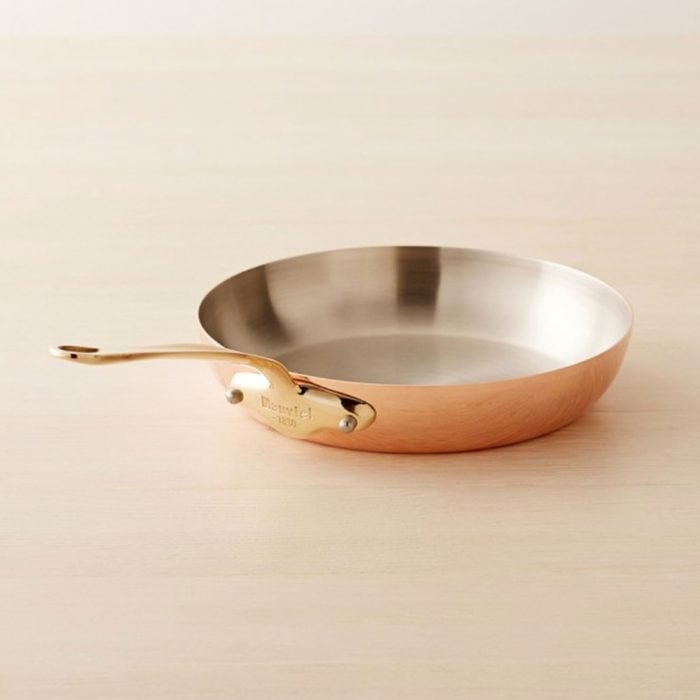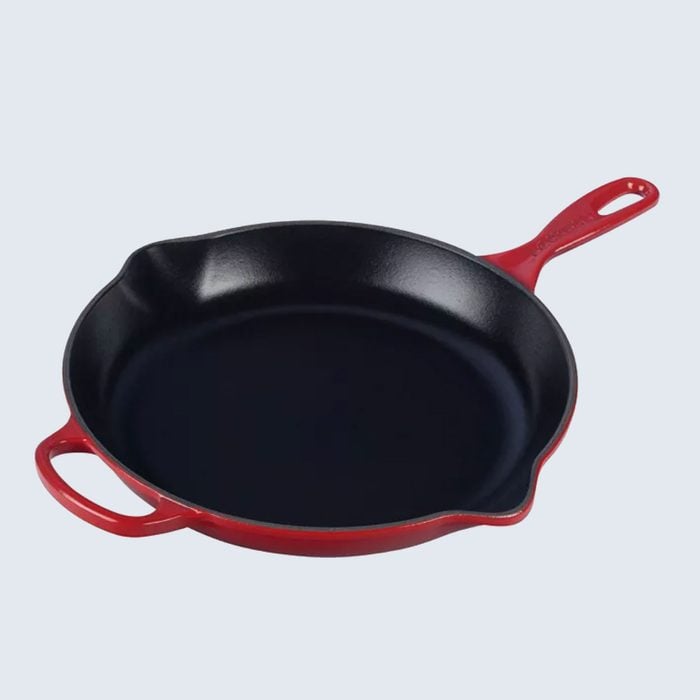Worried about chemicals in your kitchen? These cookware options will keep you safe—and deliver the most delicious results for every dish.
Our editors and experts handpick every product we feature. We may earn a commission from your purchases.
Cooking at home is supposed to be so much healthier than ordering out, but there’s one way you could be sabotaging your efforts without even realizing it: by not using the safest cookware. The materials used in certain pots and pans may not be great for you, the environment, or your food. That’s why it pays to know what you’re buying.
Pots or pans with a nonstick coating tend to arouse the most concern. That’s because they are usually made with a polymer coating whose active ingredient is called polytetrafluoroethylene (PTFE), a substance that is more slippery than wet ice, according to the Cookware Manufacturers Association. You may know PTFE by its brand name, Teflon. Studies have found that at temperatures routinely used for cooking (in the range of 400 to 500 degrees Fahrenheit), PTFE releases chemicals that may be unsafe for humans; there is evidence that the same fumes may be deadly to birds, as well. These chemicals also tend to get into our water supply and wreak havoc on the environment because they’re what the FDA calls “forever chemicals.” You may even have some habits that can hasten the wear of your nonstick items, which can ruin your food in addition to causing these other problems.
So, does that mean all nonstick pans are out? And what about your favorite stainless steel and cast iron cookware? We’re going to be honest with you: There’s a lot to think about when deciding on the right items to populate your kitchen. But we’ve made it easy by detailing the pros and cons of each type of cookware below—and highlighting a few great options. Find out which ones will keep your family safe and your food delicious in every cooking scenario.
Some of the safest metals for cookware include stainless steel, cast iron and titanium. Copper, aluminum and ceramic cookware can also be effective, though they’re best used with safety precautions.

Safest cookware for fast cooking: Titanium
Titanium cookware sets are fairly pricey, but they’re one of the safer nonstick surfaces available, according to Robert Brown, MD, author of Toxic Home/Conscious Home: A Mindful Approach to Wellness at Home. Hestan’s NanoBond line seals a stainless and aluminum pan, including the rims, with a 100 percent toxin-free chromium and titanium coating to make the surface less porous and more durable. As a result, even pans used in restaurant settings always look like new. Titanium cookware will resist staining, scratching, and salt-pitting.
Avoid: There’s really nothing these pans can’t handle, but they aren’t nonstick, so delicate foods like crepes can be tough for non-professional chefs.
Best for: Anything you want to cook hot and fast, since the pan heats up quickly, and things you need to stir often. To speed things up on busy nights, here are more ways to cook everything faster.

Safest cookware for breakfast items: Ceramic
A safer alternative to chemical-laden nonstick pans that’s more affordable than titanium, ceramic- or glass-bonded cookware has a naturally nonstick cooking surface so sleek a fried egg will slide right out, no butter needed. Brands like Caraway use a “natural inorganic sand derivative” that does not contain toxic chemicals like PFOA, PFAS, PTFE, lead, or cadmium to produce, and ceramic cookware has no issues withstanding temperatures of up to 650 degrees Fahrenheit. Ceramic-coated cookware is also non-reactive and doesn’t leach chemicals into food, so it’s good for you and the environment and is a great heat conductor.
The Always Pan from Our Place is a cult favorite that’s totally worth it. Not only can it function as a variety of cookware—a fry pan, sauté pan, steamer, skillet, saucier, saucepan, and nonstick pan—but it also boasts pour spouts and comes in seven fun colors. Plus, this 2.6-quart ceramic pan is, of course, non-toxic.
Avoid: Many ceramic coatings aren’t durable enough to withstand very high heat or rough use over time. The ceramic coating will eventually wear away, so save these pans.
Best for: Any kind of eggs, crepes, or pancakes, as well as delicate fish.

The TRUTH about Ceramic Cookware
FAQ
Is titanium ceramic cookware safe?
How safe is copper ceramic cookware?
What are the disadvantages of titanium cookware?
What is the healthiest metal to cook with?
Is titanium infused cookware safe?
Aluminum leaching. One of the most common concerns we see around titanium cookware actually applies to titanium infused cookware in general. The worry is that aluminum from the core can leach into food when cooking and contribute to health problems. However, the coating on a high quality ceramic titanium pan is non-porous.
Is ceramic cookware better than titanium?
The only downside to pure titanium is that it doesn’t have non-stick properties, which may be a bit of a pain. However, this is one tiny downside for a long-term health benefit. Pure ceramic cookware is also safe, and it’s robust. However, it is much harder to find than pure titanium.
Does titanium cookware have a nonstick coating?
Well, as we’ve mentioned a ceramic coating adds enhanced nonstick properties to the pan – properties which titanium doesn’t naturally have. A ceramic nonstick layer can be found in either pure titanium pots and pans or titanium infused cookware. Durability. Titanium is tough. Really tough!
Is copper cookware safe?
Copper cookware conducts heat well and contains copper, which similar to iron has nutritional value for people. Usually, this type of pan has a base made of another metal like stainless steel, with a copper coating over it. Copper can leach into to your food in amounts that aren’t safe to consume.
